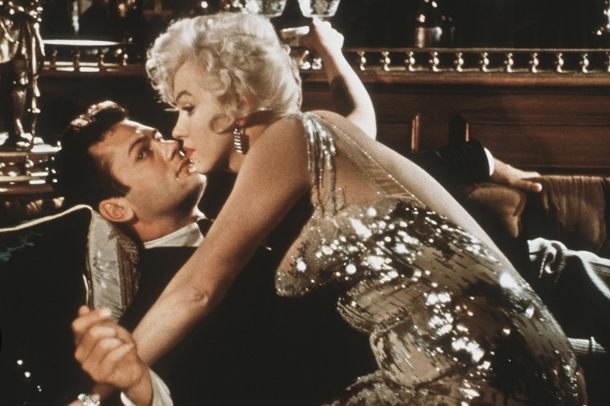An unapologetically queer 1959 Hollywood film starring Marylin Monroe that is still worth watching today
By SAVANNAH BURGER — arts@theaggie.org
During a time when America criminalized all homosexual activities and forms of queer expression, the 1959 film “Some Like It Hot” broke free of the conservative constraints of the Hays Code and presented a film featuring crossdressing, sexual fluidity and tolerance to homosexuality. Starring Marilyn Monroe, Tony Curtis and Jack Lemmon and directed by Billy Wilder, the gender-bending comedy continues to be tasteful and just as hilarious today.
The film follows Joe (Curtis) and Jerry (Lemmon) as the pair flees the mob in Chicago by joining an all-female traveling band. To be able to go undercover, the two don female personas, named Josephine and Daphne, and successfully join the band heading to Miami. Along the way, they meet Sugar Kane (Monroe), and she throws a wrench in their caper, as Joe quickly has the desire to pursue her. Once they reach Miami, Joe juggles yet another persona as a male, rich softie to win her over. Jerry, however, finds himself actually liking being Daphne, and inadvertently attracts an old millionaire named Osgood, played by Joe E. Brown, despite trying to shake him. While all these shenanigans ensue, the mob is still right around the corner.
Featuring crossdressing as a main component, the film bashed against the Hays Code, which, until 1968, prevented Hollywood movies from having any sort of lustful kissing, scenes of passion, homosexuality, gender fluidity or interracial relationships, among other constraints. To depict actors Curtis and Lemmon, who up to that point had always played strictly masculine and sometimes womanizer-like roles, as gender-bending feminine men who lean into their identities and don’t dismiss it as immoral, shook audiences back in the late 50s. Not only this, but the film’s smashing success was one of the key factors in abandoning the Hays Code almost a decade later.
The movie is still refreshing to watch today because, unlike what is to be expected of a film of its age, it didn’t make fun of the queer community at its expense. All of the characters, including the all-female band and the audience, accept Josephine and Daphne for who they are. Although a lot of the comedy is derived from Joe and Jerry’s antics as Josephine and Daphne, there are also moments where Jerry finds himself comfortable and confident in his newfound femininity. For instance, upon excitedly telling Joe that he’s been engaged, Joe asks who the lucky girl is. Jerry instantly replies with, “I am!”
While the film doesn’t have a direct, iterated stance on queerness and homosexuality, it has nods of witty acknowledgment and respect. Joe, flabbergasted with Jerry’s engagement to the millionaire Osgood, says, “But you’re not a girl! You’re a guy, and, why would a guy wanna marry a guy?” Jerry snaps back, “Security!” Even with jokes, the writing never reflects a dismissal or degradation of queer love or attraction, something unheard of in 1959.
This is coupled with the most famous line of the whole movie, which is in the very ending scene. Jerry attempts to explain to Osgood, who is set on their marriage, that they can’t go through with it, making up a myriad of reasons, but Osgood is persistent. Eventually, Jerry rips off his blonde wig and shouts, “I’m a man!” thinking that will surely ward off the millionaire, but is shocked when Osgood replies without hesitation, “Well, nobody’s perfect,” insinuating that gender doesn’t make a difference to Osgood; he’s in love with Daphne nonetheless.
This act of unapologetic queerness is one of the many reasons that makes “Some Like It Hot” still relevant today — every act of queerness or gender fluidity is embraced and made light of in a classy way. In our current political climate here in the United States and beyond, it is refreshing to see a much older film have such an accepting take on queerness as a whole. This is especially true when it seems that 65 years later, not much progress has been made when it comes to accepting and respecting people’s identities, queer or not. So, if you’re looking for a hilarious, positive, queer-coded 1950s flick to watch, give Wilder’s classic a go.
Written by: Savannah Burger — arts@theaggie.org





